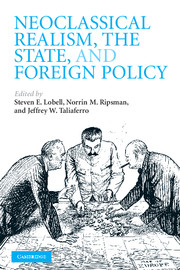Book contents
- Frontmatter
- Contents
- List of figures
- List of tables
- List of contributors
- Acknowledgments
- 1 Introduction: Neoclassical realism, the state, and foreign policy
- 2 Threat assessment, the state, and foreign policy: a neoclassical realist model
- 3 Neoclassical realism and strategic calculations: explaining divergent British, French, and Soviet strategies toward Germany between the world wars (1919–1939)
- 4 Neoclassical realism and identity: peril despite profit across the Taiwan Strait
- 5 Neoclassical realism and the national interest: presidents, domestic politics, and major military interventions
- 6 Neoclassical realism and domestic interest groups
- 7 Neoclassical realism and resource extraction: State building for future war
- 8 Neoclassical realism and state mobilization: expansionist ideology in the age of mass politics
- 9 The limits of neoclassical realism: additive and interactive approaches to explaining foreign policy preferences
- 10 Conclusion: The state of neoclassical realism
- Index
- References
4 - Neoclassical realism and identity: peril despite profit across the Taiwan Strait
Published online by Cambridge University Press: 05 June 2012
- Frontmatter
- Contents
- List of figures
- List of tables
- List of contributors
- Acknowledgments
- 1 Introduction: Neoclassical realism, the state, and foreign policy
- 2 Threat assessment, the state, and foreign policy: a neoclassical realist model
- 3 Neoclassical realism and strategic calculations: explaining divergent British, French, and Soviet strategies toward Germany between the world wars (1919–1939)
- 4 Neoclassical realism and identity: peril despite profit across the Taiwan Strait
- 5 Neoclassical realism and the national interest: presidents, domestic politics, and major military interventions
- 6 Neoclassical realism and domestic interest groups
- 7 Neoclassical realism and resource extraction: State building for future war
- 8 Neoclassical realism and state mobilization: expansionist ideology in the age of mass politics
- 9 The limits of neoclassical realism: additive and interactive approaches to explaining foreign policy preferences
- 10 Conclusion: The state of neoclassical realism
- Index
- References
Summary
The introductory chapter of this volume by Jeffrey Taliaferro, Steven Lobell, and Norrin Ripsman suggests that neoclassical realism can add explanatory power to structural realism by considering the effect of the domestic political environment on policy. It also improves on liberal theories by asserting the primacy of international constraints. In this chapter, I examine whether a neoclassical realist approach can explain a liberal puzzle, namely the persistence of security competition between trade partners and the absence of peace dividends between economically interdependent states. In other words, why do states continue to perceive each other as security threats despite increased economic interdependence between them? How is it possible for states that are engaged in an active security conflict to continue trading with one another? Why does the purported peace dividend of economic interdependence so often fail to materialize?
That there should be a peace dividend is an assumption with deep philosophical roots. It is an assumption that has served as the analytical bedrock for a variety of liberal theoretical projects in the international relations discipline, and it continues to inform foreign policy and decision-making throughout the globe. The result is, as Katherine Barbieri and Gerald Schneider note, that “most leaders still cling to the longstanding belief that expanding economic ties will cement the bonds of friendship between and within nations that make the resort to arms unfathomable,” and “few scholars today question the belief that trade brings universal benefits and peace under all conceivable conditions.”
- Type
- Chapter
- Information
- Neoclassical Realism, the State, and Foreign Policy , pp. 99 - 138Publisher: Cambridge University PressPrint publication year: 2009
References
- 34
- Cited by

